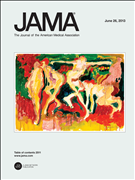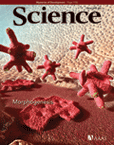Nature:一种简单的分子可以防止鼹鼠患癌症
2013-06-26 佚名 MedSci原创
同样的分子可以让裸鼹鼠的皮肤有弹性,也可以防止啮齿动物患上癌症。自然的网站上今天公布的一项关于含糖细胞的分泌物能够阻止肿瘤扩散的研究。 裸鼹鼠是与豪猪关系比老鼠更密切相关的动物,是大自然的怪胎。作为短视的动物,他们过着地下殖民地生活,是有史以来发现的仅有的两个“完全社会性'哺乳动物之一。鼠类不感到刺痛酸或烧伤辣椒,似乎是唯一无法调节体温的的哺乳动物。 然而,由于它们对癌症的抵抗力太差,致使裸鼹
同样的分子可以让裸鼹鼠的皮肤有弹性,也可以防止啮齿动物患上癌症。自然的网站上今天公布的一项关于含糖细胞的分泌物能够阻止肿瘤扩散的研究。
裸鼹鼠是与豪猪关系比老鼠更密切相关的动物,是大自然的怪胎。作为短视的动物,他们过着地下殖民地生活,是有史以来发现的仅有的两个“完全社会性'哺乳动物之一。鼠类不感到刺痛酸或烧伤辣椒,似乎是唯一无法调节体温的的哺乳动物。
然而,由于它们对癌症的抵抗力太差,致使裸鼹鼠的寿命很短。纽约州罗切斯特大学的生物学家安德烈Seluanov将80只裸鼹鼠放在一个特殊的设施内,并且活到32岁,科学家们从未发现它们其中有患癌症的。与小鼠相比,它们通常很少有活过四岁,基本死于癌症。
2009年, Seluanov的团队报道称,裸鼹鼠的成纤维细胞(存在于结缔组织细胞类型)是比其它细胞更敏感,在培养皿中,他们的成长没有小鼠成纤维细胞那么拥挤。他的实验室工作人员很烦恼,他们培养细胞的肉汤往往变成粘稠,堵塞了排水沟。
“我们的实验人员很不高兴,因为她需要拆解系统来清洁这一些糊糊的东西, ” Seluanov回忆说。 “我告诉我的研究生,我们必须找出糊糊的物质是什么 , 它应该与抗肿瘤作用有关。当然,在那个时候,只是胡乱猜测。 ”
该小组很快发现,管道问题是由于一个名为透明质酸(HA )的糖。成纤维细胞渗出HA ,随着胶原蛋白和其他化学物质,它构成了组织的细胞外基质,并使皮肤有弹性。 Seluanov的研究小组发现裸鼹鼠能够产生大量的长链的HA。
研究人员怀疑长的HA分子在细胞周围形成了严密的笼子,防止肿瘤细胞的复扩散,将'癌症'抑制在萌芽状态。裸鼹鼠的细胞组织培养实验,可以通过阻断该基因编码HA或通过提高一种蛋白质水平来回收糖。当在小鼠的皮肤下植入这些细胞时时,很容易形成肿瘤。
马萨诸塞州波士顿哈佛医学院的分子生物学家Vadim Gladyshev,他说,这种机制有助于裸鼹鼠对癌症抵抗作用,但他补充说,其它一些机制可能发挥了一部分。例如,当他和他的同事对动物的基因组进行测序,他们发现裸鼹鼠的许多与癌症有关的基因与其他脊椎动物不同。
Rochelle Buffenstein是圣安东尼奥得克萨斯大学健康科学中心老年病学的一名研究者,这里拥有2500只动物,是世界最大的裸鼹鼠 - 大鼠克隆的研究基地,他说,现在不明白HA是如何对抗癌症,但是,对裸鼹鼠抗癌机制将的研究将提供这种洞察力,可以用于应对人类癌症。
Seluanov的团队计划利用这种方法在实验室的小鼠身上进行实验。研究人员希望能利用基因工程赋予老鼠与那些裸鼹鼠一样的HA分子。他说导致生产长HA分子的药物可能有一天会被证明是有益预防人类癌症。

High-molecular-mass hyaluronan mediates the cancer resistance of the naked mole rat
The naked mole rat (Heterocephalus glaber) displays exceptional longevity, with a maximum lifespan exceeding 30 years1, 2, 3. This is the longest reported lifespan for a rodent species and is especially striking considering the small body mass of the naked mole rat. In comparison, a similarly sized house mouse has a maximum lifespan of 4 years4, 5. In addition to their longevity, naked mole rats show an unusual resistance to cancer. Multi-year observations of large naked mole-rat colonies did not detect a single incidence of cancer2, 6. Here we identify a mechanism responsible for the naked mole rat’s cancer resistance. We found that naked mole-rat fibroblasts secrete extremely high-molecular-mass hyaluronan (HA), which is over five times larger than human or mouse HA. This high-molecular-mass HA accumulates abundantly in naked mole-rat tissues owing to the decreased activity of HA-degrading enzymes and a unique sequence of hyaluronan synthase 2 (HAS2). Furthermore, the naked mole-rat cells are more sensitive to HA signalling, as they have a higher affinity to HA compared with mouse or human cells. Perturbation of the signalling pathways sufficient for malignant transformation of mouse fibroblasts fails to transform naked mole-rat cells. However, once high-molecular-mass HA is removed by either knocking down HAS2 or overexpressing the HA-degrading enzyme, HYAL2, naked mole-rat cells become susceptible to malignant transformation and readily form tumours in mice. We speculate that naked mole rats have evolved a higher concentration of HA in the skin to provide skin elasticity needed for life in underground tunnels. This trait may have then been co-opted to provide cancer resistance and longevity to this species.
本网站所有内容来源注明为“梅斯医学”或“MedSci原创”的文字、图片和音视频资料,版权均属于梅斯医学所有。非经授权,任何媒体、网站或个人不得转载,授权转载时须注明来源为“梅斯医学”。其它来源的文章系转载文章,或“梅斯号”自媒体发布的文章,仅系出于传递更多信息之目的,本站仅负责审核内容合规,其内容不代表本站立场,本站不负责内容的准确性和版权。如果存在侵权、或不希望被转载的媒体或个人可与我们联系,我们将立即进行删除处理。
在此留言










#Nat#
89
#患癌#
72